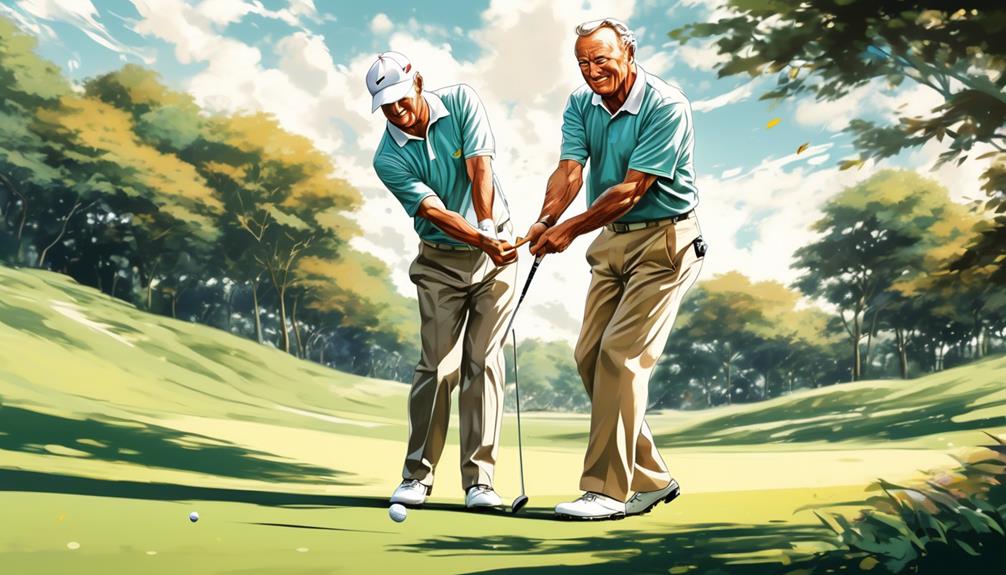

Imagine standing on the first tee, the early morning mist gently rising from the fairway. As you watch the ball soar through the air with perfect precision, you can’t help but wonder: what makes Arnold Palmer’s swing so legendary?
Well, you’re in luck. In this discussion, we will explore the seven best techniques from Arnold Palmer’s swing that have helped him achieve greatness on the golf course.
From his impeccable grip to his powerful follow-through, each aspect of his swing holds valuable lessons for aspiring golfers like yourself.
So, get ready to discover the secrets behind Palmer’s success and take your own game to new heights.
Key Takeaways
- Proper grip and stance are essential for optimal wrist hinge and release.
- Consistent tempo and a full shoulder turn during the backswing lead to power and control.
- Smooth and controlled downswing, with a focus on lower body rotation, generates maximum power and accuracy.
- Clubface control, wrist hinge, and a strong finish position contribute to accuracy and power in the swing.
Grip


To achieve a precise and powerful swing, mastering the proper grip is paramount in adopting Arnold Palmer’s swing techniques. The correct grip is essential because it sets the foundation for a golfer’s swing. Hand placement plays a crucial role in achieving consistency and control in your shots.
When gripping the club, your left hand should be positioned so that the handle runs diagonally across the base of your fingers, with the club resting on the pad of your left hand. The ‘V’ formed by your thumb and index finger should point towards your right shoulder. This grip allows for a strong connection between the club and your left hand, providing stability and control.
Your right hand should then be placed below your left hand on the club, with the ‘V’ formed by your thumb and index finger pointing towards your right shoulder as well. The grip pressure should be firm but not overly tight. This balanced grip allows for optimal wrist hinge and release during the swing.
The importance of hand placement can’t be overstated. It influences clubface control, shot direction, and overall swing mechanics. A correct grip ensures that the clubface is square at impact, leading to straighter and more accurate shots. It also promotes a smooth and consistent swing path, resulting in better ball striking and distance control.
Stance


Mastering the proper stance is crucial in adopting Arnold Palmer’s swing techniques for achieving balance, power, and consistency in your golf shots. To achieve a solid and effective stance, pay attention to the following key elements:
- Weight distribution: Distribute your weight evenly between your feet to establish a stable foundation. This helps maintain balance throughout the swing and enables you to transfer power efficiently.
- Foot positioning: Position your feet slightly wider than shoulder-width apart, with your toes pointing slightly outward. This stance provides stability and allows for proper rotation and weight transfer during the swing.
- Alignment: Align your feet, hips, and shoulders parallel to the target line. This ensures that your body is properly aligned with the intended path of the shot, reducing the chances of misalignment and inconsistent ball striking.
Backswing


Now that you have established a solid stance with proper weight distribution and foot positioning, it’s time to focus on the pivotal element of the backswing in Arnold Palmer’s swing techniques.
The backswing is a crucial part of the golf swing as it sets the stage for a powerful and accurate shot. One key aspect to consider during the backswing is the tempo. Maintaining a consistent tempo throughout the backswing helps in generating power and maintaining control. It’s important to avoid rushing the backswing or making it too slow, as both extremes can lead to inconsistencies in your shots.
Another important element of the backswing is the rotation of the upper body. As you begin your backswing, focus on rotating your torso while keeping your arms relaxed and connected to your body. This rotation helps to create a coil-like effect, storing potential energy that can be unleashed during the downswing. The rotation of the upper body also allows for a full shoulder turn, which is essential for generating power and maintaining a solid swing plane.
Transition
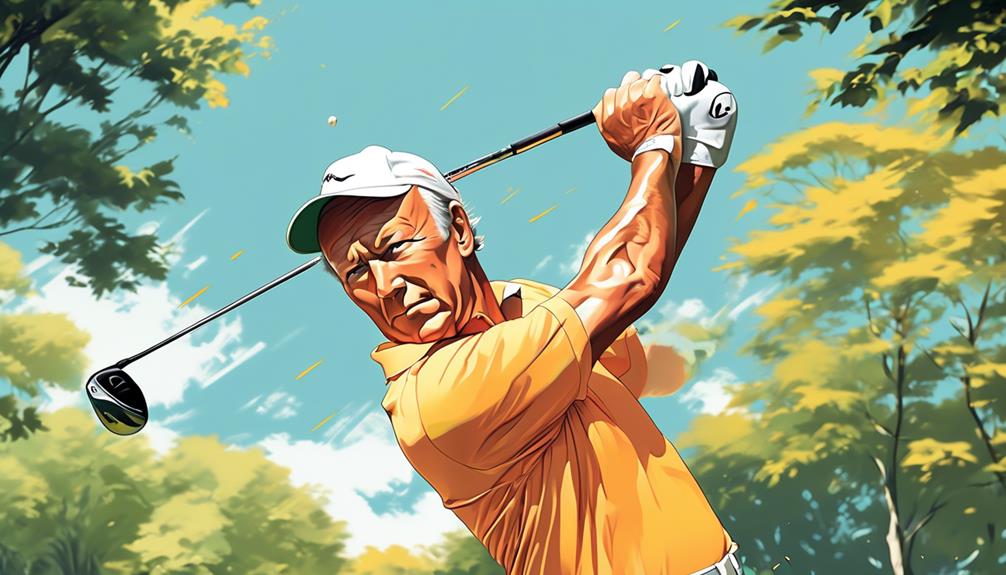

During the transition phase of Arnold Palmer’s swing techniques, the focus shifts from the backswing to the beginning of the downswing, where a seamless transfer of power and momentum occurs. This crucial phase sets the stage for a powerful and accurate strike.
Here are three key elements that define the transition in Palmer’s swing:
- Weight Transfer: As you transition from the backswing to the downswing, it’s essential to transfer your weight smoothly from your back foot to your front foot. This shift of weight initiates the downward motion of the club and ensures that you generate maximum power through impact.
- Lower Body Rotation: Successful transition requires efficient rotation of the lower body. As you shift your weight, allow your hips to rotate towards the target. This rotational movement generates torque and adds power to your swing, resulting in increased clubhead speed.
- Sequencing: To achieve a seamless transition, it’s crucial to maintain the proper sequencing of movements. Start with the lower body, followed by the torso, arms, and finally, the club. This sequential movement allows for a smooth transfer of energy and ensures that each body segment contributes to the power and accuracy of your strike.
Downswing
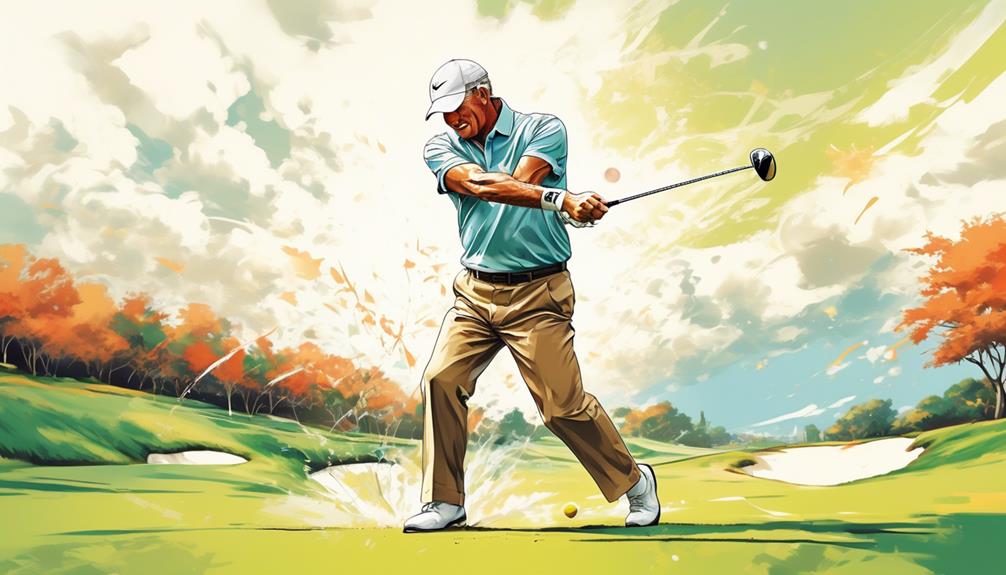

Moving from the transition phase, Arnold Palmer’s swing techniques seamlessly transition into the downswing, where the focus shifts towards delivering maximum power and precision at impact. The downswing is a critical phase in the golf swing, and understanding the proper tempo and sequencing is essential for a successful shot.
Downswing tempo refers to the speed at which the clubhead accelerates through the impact zone. Palmer’s technique emphasized a smooth and controlled tempo, allowing him to generate tremendous power while maintaining accuracy. It’s important to avoid rushing the downswing, as this can lead to a loss of control and inconsistent ball striking.
Downswing sequencing is another crucial aspect of Palmer’s swing. He believed in starting the downswing with a slight shift of the hips towards the target, followed by a gradual rotation of the torso. This sequential movement allowed for an efficient transfer of energy from the lower body to the upper body, resulting in a powerful and controlled release of the clubhead.
Impact
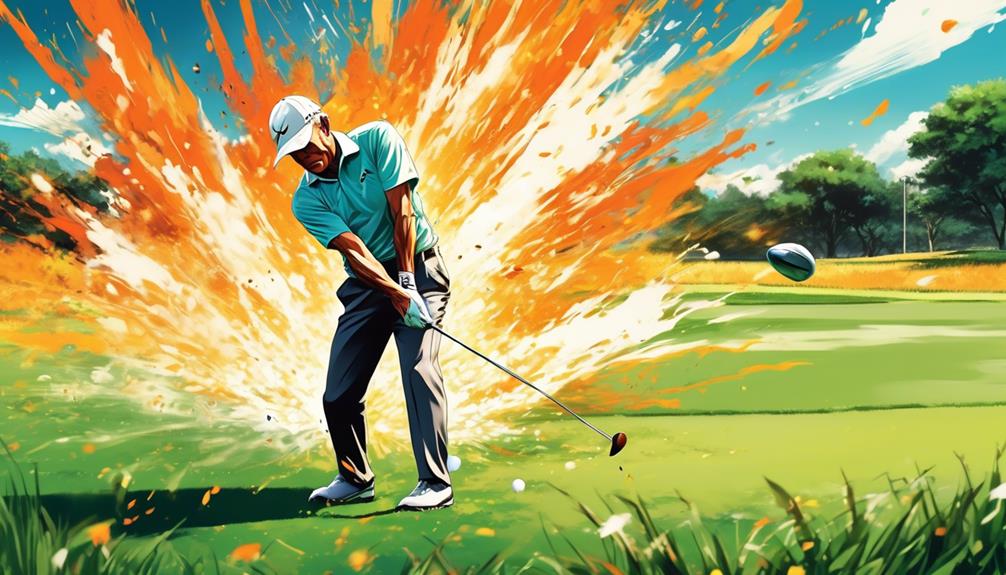

Now, let’s turn our attention to the critical moment of impact in Arnold Palmer’s swing.
Two key factors to consider are power at impact and clubface control.
At impact, Palmer generates immense power through a combination of his lower body rotation, upper body extension, and a timely release of the club.
Additionally, his exceptional clubface control allows him to consistently strike the ball with precision, resulting in accurate shots.
Understanding and implementing these techniques can significantly improve your own impact position and overall swing performance.
Power at Impact
To maximize power at impact in your swing, focus on maintaining a strong and stable base while transferring energy smoothly from your lower body to your upper body. Here are three key techniques to help you generate maximum clubhead speed and ensure proper weight transfer:
- Ground connection: Start by planting your feet firmly into the ground, creating a solid foundation. This will allow you to generate power from the ground up and transfer it efficiently through your swing.
- Lower body rotation: Initiate the downswing by rotating your hips towards the target. This rotational movement generates torque, which translates into clubhead speed. Remember to keep your lower body stable and connected to the ground to maintain balance and power.
- Upper body coil: As your lower body initiates the downswing, your upper body should coil in the opposite direction. This separation between the upper and lower body creates a stretch in your core muscles, storing energy that can be released at impact.
Clubface Control
Maintaining control of the clubface at impact is crucial for achieving accuracy and consistency in your golf swing.
To ensure proper clubface control, two key factors must be considered: correct ball position and wrist hinge during the swing.
Firstly, the correct ball position is essential for a square clubface at impact. If the ball is too far forward or back in your stance, it can lead to an open or closed clubface, resulting in errant shots.
Secondly, the wrist hinge plays a significant role in controlling the clubface. As you hinge your wrists during the backswing, you create lag and store energy, allowing for a powerful and controlled release through impact.
Follow-through
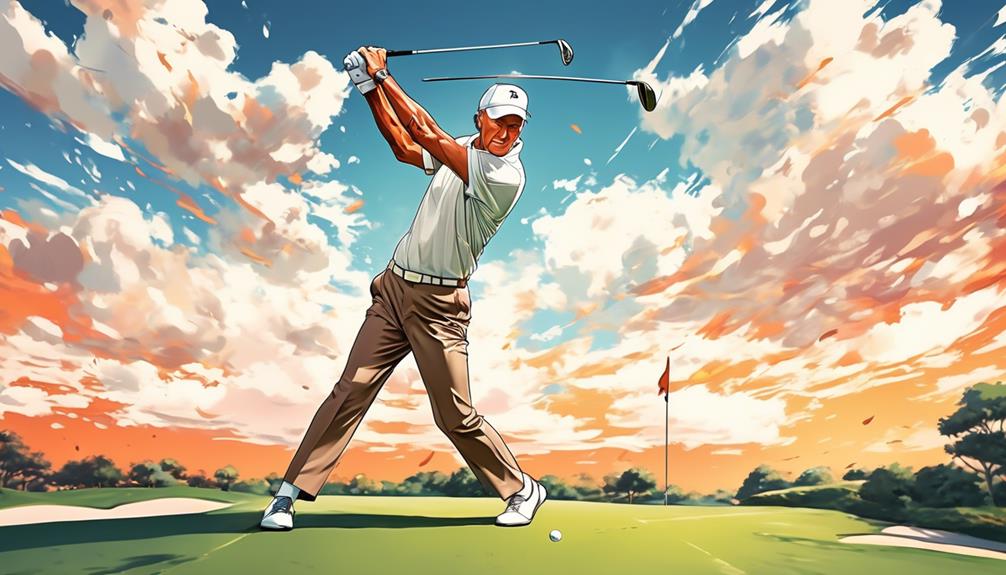

As you transition from impact to follow-through, it’s crucial to maintain a strong finish position. This means keeping your body balanced, your hips rotated, and your arms extended.
The extension and balance in your follow-through will help generate power and accuracy in your shots. Additionally, paying attention to the timing of your clubhead
release will ensure proper contact with the ball and a smooth, controlled follow-through.
Strong Finish Position
A strong finish position in Arnold Palmer’s swing techniques is crucial for maximizing power and accuracy in your golf shots. To achieve a strong finish, you need to focus on proper weight transfer, hip rotation, and maintaining balance throughout the swing.
- Proper weight transfer: Shift your weight from your back foot to your front foot during the downswing. This transfer of weight helps generate power and allows for a more controlled and balanced finish.
- Hip rotation: Engage your hips by initiating the downswing with a rotational movement. This hip rotation adds speed and power to your swing, creating a solid foundation for a strong finish.
- Balance: Maintain a balanced stance throughout the swing and follow-through. This ensures that you stay centered and in control, allowing for a smooth and powerful finish position.
Extension and Balance
To achieve a powerful and accurate swing like Arnold Palmer, it’s essential to focus on extension and balance during your follow-through.
Extension refers to the full extension of your arms and club after impact, while balance ensures that you maintain a stable position throughout the swing.
During the follow-through, proper weight distribution is crucial. As you rotate your hips and transfer your weight from the back foot to the front foot, you should feel a smooth transition and a balanced finish. This weight shift allows for maximum power and control.
Additionally, hip rotation plays a significant role in generating clubhead speed and maintaining balance. By engaging your hips and rotating them towards the target, you create a strong and stable foundation for your swing, resulting in better extension and balance throughout.
Remember to practice these techniques consistently to improve your swing and achieve greater accuracy and power.
Why Is Tiger Woods’ Golfing Legacy Unraveling?
Clubhead Release Timing
The timing of the clubhead release during the follow-through is a critical element in achieving a consistent and powerful swing like Arnold Palmer’s. To master this aspect, you must focus on tempo control and wrist hinge.
Here are three key factors to consider:
- Tempo control: Maintaining a smooth and balanced tempo throughout your swing is crucial for a well-timed clubhead release. Rushing or decelerating can lead to inconsistencies and loss of power. Practice controlling your swing tempo to ensure a synchronized release.
- Wrist hinge: Proper wrist hinge allows for maximum power transfer and control during the release. As you approach impact, maintain a firm yet flexible wrist position, allowing for a delayed release and increased clubhead speed.
- Timing synchronization: The release of the clubhead should coincide with the rotation of your body and the extension of your arms. Aim to synchronize these movements to achieve a powerful and efficient release.
Frequently Asked Questions
What Were Arnold Palmer’s Strategies for Mental Focus and Concentration During His Swing?
To improve mental focus and concentration during your swing, engage in mental preparation and utilize visualization techniques. These strategies will help you stay focused on your shot and enhance your overall performance on the golf course.
Pioneering Golf Greatness: Tiger Woods’ Timeless Impact
How Did Arnold Palmer Adapt His Swing Technique to Different Weather Conditions?
In different weather conditions, Arnold Palmer’s swing techniques allowed him to adapt and excel. His mental strategies for focus and concentration further enhanced his performance, making him a legend in the golfing world.
Did Arnold Palmer Have Any Specific Training Drills or Exercises to Improve His Swing?
To improve your swing like Arnold Palmer, incorporate specific training drills and exercises. Focus on building core strength, practicing with weighted clubs, and using alignment sticks for proper positioning. These techniques will help refine your swing and enhance your overall performance.
3 Best Moments in Tiger Woods’ Legendary Journey
What Were Some of the Common Mistakes That Arnold Palmer Observed in Amateur Golfers’ Swings?
When it comes to common swing mistakes, Arnold Palmer observed that amateur golfers often struggled with improper grip, lack of balance, and incorrect weight transfer. These flaws hindered their ability to achieve a powerful and accurate swing.
How Did Arnold Palmer Handle Pressure Situations and Maintain Consistency in His Swing During Major Tournaments?
To handle pressure and maintain consistency in your swing during major tournaments, study Arnold Palmer’s mental game. Learn how he adjusted his technique and mindset to stay focused and perform at his best under high-stakes situations.
What Is Arnold Palmer’s Impact on Modern Golfers?
Conclusion
In conclusion, by closely analyzing the seven best techniques from Arnold Palmer’s swing, it becomes evident that his mastery lies in the perfect combination of grip, stance, backswing, transition, downswing, impact, and follow-through.
Each element seamlessly connects to the next, creating a harmonious flow that allows Palmer to generate incredible power and accuracy.
With diligent practice and attention to detail, aspiring golfers can strive to incorporate these techniques into their own swings, aiming for excellence on the course.
Discover Arnold Palmer’s Legendary Golfing Secrets: Take the Quiz







